Caine and Kane and Kavalier
The Caine Mutiny is a great movie for our moment, because it’s a story that has a kind of relentless moral momentum. You can see almost from the beginning what the shape of the story is, where it’s headed, and everything that happens confirms and strengthens the understanding with which you began.
That is, until Barney Greenwald (José Ferrer) comes on the scene three-quarters of the way through the movie and turns your world upside down. Until then you thought there was only one way to tell the story; you thought that its shape was inescapable. And then Greenwald shows up to remind you, or rather instruct you, that what you saw throughout the story was indeed true, but was never the whole truth. There were huge broad swaths of truth to which you were completely blind, and you were completely blind to them because you were so enjoying the satisfaction of being on the right side of events.


Speaking homonymously, I’ve been working on an essay about Citizen Kane — and Pauline Kael’s notorious, or perhaps infamous, essay on the film — and I find myself often reflecting on this wonderful passage from Michael Chabon’s The Amazing Adventures of Kavalier and Clay, in which Joe Kavalier — a young Jewish refugee from Prague living in New York City and beginning a career as an illustrator of comics — goes to the theater to see Citizen Kane. He finds himself thinking, and trying to explain to his cousin and collaborator Sammy, that Kane, “more than any other movie Joe had ever seen,” achieved “the total blending of narration and image that was … the fundamental principle of comic book story telling.”
Without the witty, potent dialogue and the puzzling shape of the story, the movie would have merely been an American version of the kind of brooding, shadow-filled … expressionist stuff that Joe had grown up watching in Prague. Without the brooding shadows and bold adventurings of the camera, without the theatrical lighting and queasy angles, it would have been merely a clever movie about a rich bastard. It was more, much more, than any movie really needed to be. In this one crucial regard — its inextricable braiding of image and narrative — Citizen Kane was like a comic book.
If you look at the black-and-white comics of the masterful Will Eisner, the similarities of Eisner’s visual language to that of Citizen Kane are pretty clear.

STATUS BOARD
- Work: Words, words, words.
- Music: Nobody is sure how many string quartets Haydn wrote, but there are at least sixty, and the last thirty of them are consistently inventive and surprising and delightful.
- Reading: Work on my book recently gave me a reason to re-read one of my very favorite novels, Anita Desai’s Clear Light of Day, and I found it as luminous as ever. “Masterpiece” is not too strong a word.
- Food and Drink: It’s the season for making, and drinking lots of, sun tea.